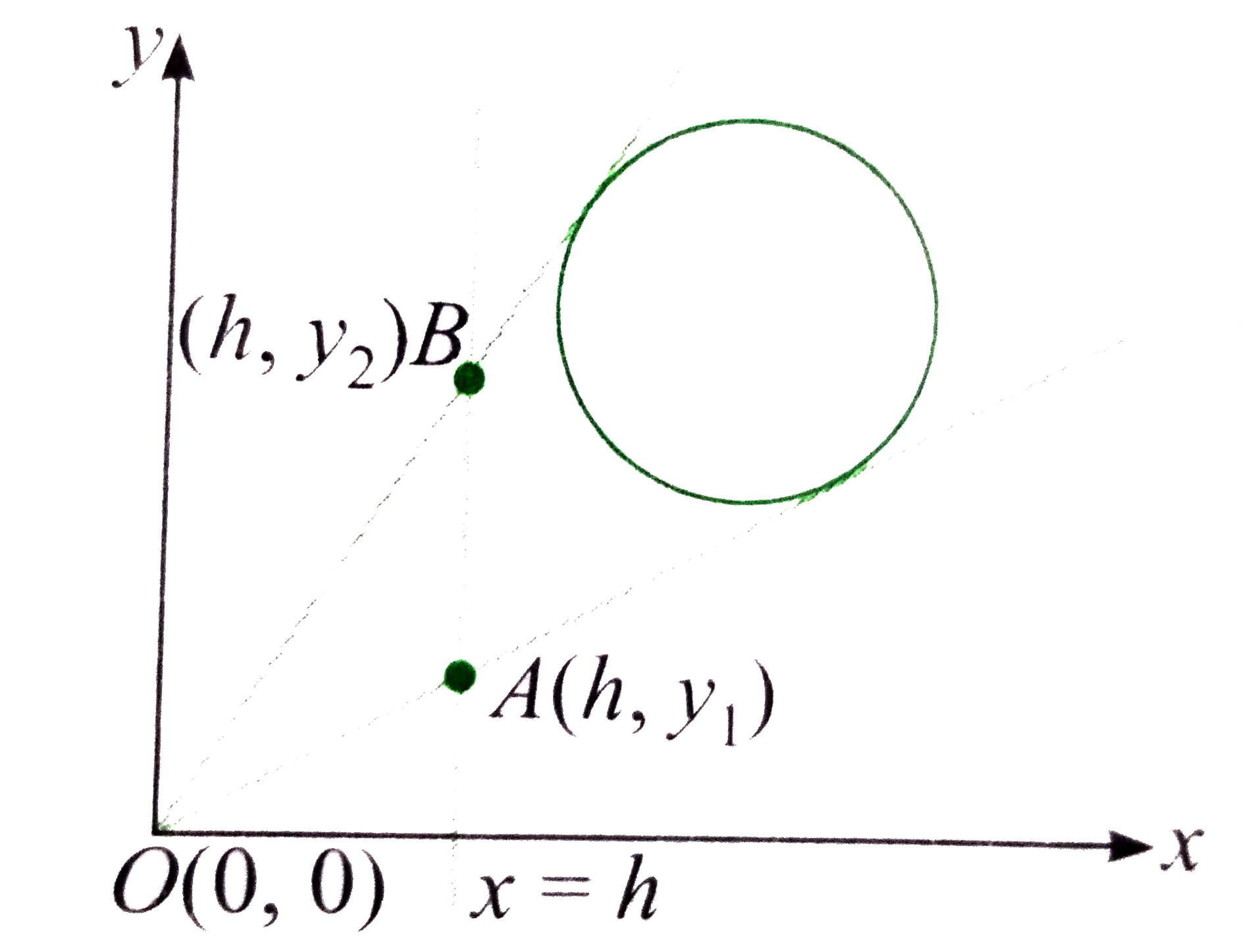The squared length of the intercept made by the line x=h on the pair of tangents drawn from the origin to the circle x2+y2+2gx+2fy+c=0 is 4ch2(g2−c)2(g2+f2−c) 4ch2(f2−c)2(g2+f2−c) 4ch2(f2−f2)2(g2+f2−c) (d) none of theseSolution in Bengali
4ch2(g2−c2)(g2+f2−c)
4ch2(f2−c2)(g2+f2−c)
4ch2(g2−f2)2(g2+f2−c)
none of these
The correct Answer is:2
The equation of the pair of tangents from (0,0) is SS'=T2
or (x2+y2+2gx+2fy+c)c=(gx+fy+c)2 (1)
The intersection points of the above pair with x=h are given by
(gh+fy+c)2=(h2+y2+2gh+2fy+c)c
or (f2−c)y2+2fghy+h2(g2−c)=0

If its roots are y1 and y2, then the length of intercept
AB2=|y1−y2|2
=(y1+y2)2−4y1y2
=(2fghf2−c)2−4h2(g2−c)f2−c
=4ch2(f2−c)2(g2+f2−c)
Topper's Solved these Questions
- BOOK - CENGAGE PUBLICATIONCHAPTER - CIRCLE EXERCISE - Multiple Correct Anser Type29videos
CIRCLE
- BOOK - CENGAGE PUBLICATIONCHAPTER - CIRCLE EXERCISE - Linked Comprehension Type (For Problem 1-3)3videos
CIRCLE
- BOOK - CENGAGE PUBLICATIONCHAPTER - CIRCLE EXERCISE - CONCEPT APPLICATION EXERCISE 4.172videos
CIRCLE
- BOOK - CENGAGE PUBLICATIONCHAPTER - BINOMIAL THEOREMEXERCISE - Comprehension11videos
BINOMIAL THEOREM
- BOOK - CENGAGE PUBLICATIONCHAPTER - CIRCLESEXERCISE - Comprehension Type8videos
CIRCLES
Similar Questions
about to only mathematics
02:42View SolutionEach side of a square is of length 6 units and the centre of the square Is ( - 1, 2). One of its diagonals is parallel to x+y=0. Find the co-ordinates of the vertices of the square.
05:54View SolutionThree concentric circles of which the biggest is x2+y2=1, have their radii in A.P If the line y=x+1 cuts all the circles in real and distinct points. The interval in which the common difference of the A.P will lie is:
03:51View SolutionConsider a G.P. with first term (1+x)n, |x|<1, common ratio 1+x2 and number of terms (n+1). Let 'S' be sum of all the terms of the G.P., then
The coefficient of xn is 'S' is03:51View Solution
In the diagram as shown, a circle is drawn with centre C(1,1) and radius 1 and a line L. The line L is tangent to the circle at Q. Further L meets the y-axis at R and the x-axis at P in such a way that the angle OPQ equals θ where 0<θ<π2.
Coordinate of Q is05:19View SolutionIf the angle between the tangents drawn to x2+y2+2gx+2fy+c=0 from (0, 0) is π2, then g2+f2=3c g2+f2=2c g2+f2=5c g2+f2=4c
08:16View SolutionThe squared length of the intercept made by the line x=h on the pair of tangents drawn from the origin to the circle x2+y2+2gx+2fy+c=0 is 4ch2(g2−c)2(g2+f2−c) 4ch2(f2−c)2(g2+f2−c) 4ch2(f2−f2)2(g2+f2−c) (d) none of these
03:59View SolutionIf equation of the circle is in the form of x^(2)+y^(2)+2gx+2fy+c=0 then prove that its centre and radius will be (-g,-f) and sqrt(g^(2)+f^(2)-c respectively.)
01:49View SolutionIf equation of the circle is in the form of x^(2)+y^(2)+2gx+2fy+c=0 then prove that its centre and radius will be (-g,-f) and sqrt(g^(2)+f^(2)-c respectively.)
View SolutionIf a circle x^(2)+y^(2)+2gx+2fy+c=0 completely lies within the two lines x+y=2 and x+y=-2 then: min{|g+f+2|,|g+f-2|} is
04:13View SolutionEquation of a circle that cuts the circle x2+y2+2gx+2fy+c=0, lines x=gandy=f orthogonally is : (A) x2+y2−2gx−2fy−c=0 (B) x2+y2−2gx−2fy−2g2−2f2−c=0 (C) x2+y2+2gx+2fy+g+f2−c=0 (D) none of these
03:43View SolutionLet f be a twice differentiable function such that
f''(x)=−f(x) and f'(x)=g(x).If h'(x)=[f(x)]2+[g(x)]2,
h(a)=8 and h(0)=2, then h(2)=08:22View SolutionIf g2+f2=c, then the equation x2+y2+2gx+2fy+c=0 will represent
07:16View SolutionA: If origin is a limiting point of the coaxal system containing the circle
x2+y2+2gx+2fy+c=0 then the other limiting point is (−gcg2+f2,−fcg2+f2)08:38View SolutionIf ax2+2hxy+by2+2gx+2fy+c≡(lx+my+n)(l'x+m'y+n'), then prove that :
∣∣ ∣ ∣∣ahghbfgfc∣∣ ∣ ∣∣=001:09View SolutionIf the angle between the tangents drawn to x2+y2+2gx+2fy+c=0 from (0, 0) is π2, then g2+f2=3c g2+f2=2c g2+f2=5c g2+f2=4c
02:28View Solution

